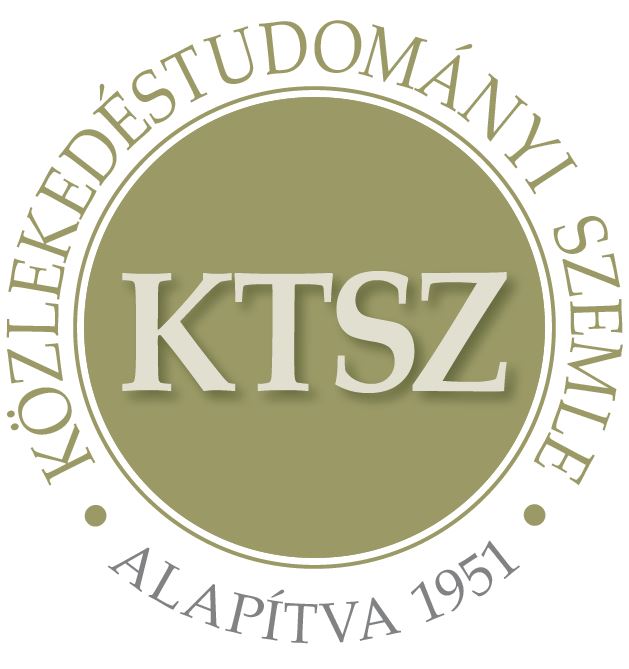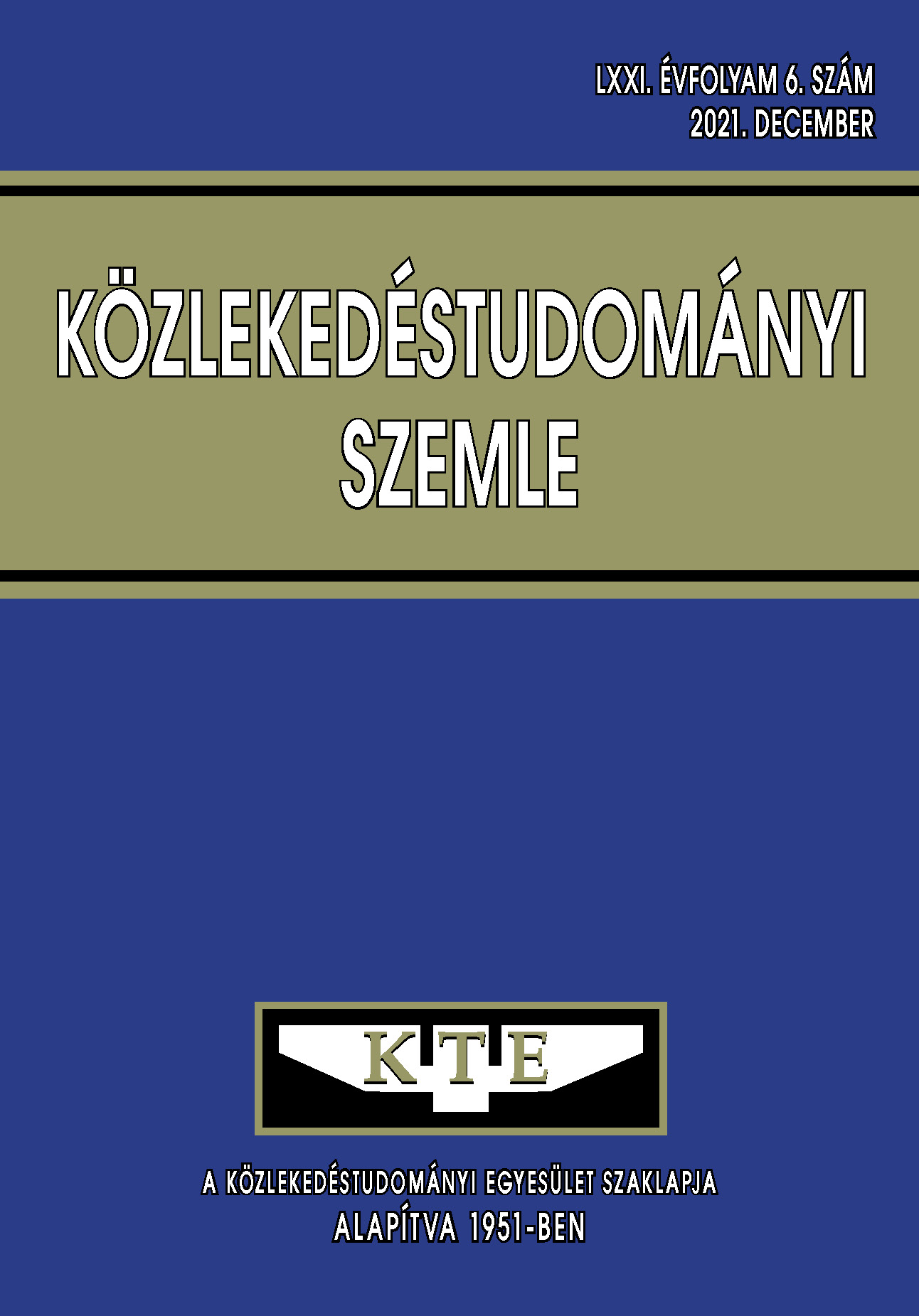Közösségi közlekedési módok súlyszámának meghatározása városi környezetben – egy lehetséges módszertan
Absztrakt
A különböző városi közlekedési módok rangszámfüggésének vizsgálatánál a rangszám azt reprezentálja, hogy az adott település milyen szintű régiónak a központja. A vizsgálat során egy lineáris regressziós modellt építettek fel a különböző közlekedési módok súlyszámának a meghatározásához.
Hivatkozások
Európai Bizottság, ‘Fehér Könyv – Útiterv az egységes európai közlekedési térség megvalósításához – Úton egy versenyképes és erőforrás-hatékony közlekedési rendszer felé’, Európai Bizottság, Brüsszel, COM/2011/0144, Mar. 2011. Accessed: May 30, 2021. [Online]. Available: https://eurlex.europa.eu/legal-content/HU/TXT/PDF/?uri=CELEX:52011DC0144&qid=1622382850857&from=HU
Szabó Z. and Török Á., ‘Tranzitforgalmak Magyarországon: Egy térökonometriai elemzés’, Közlekedéstudományi Konferencia, vol. 8, pp. 201–212, 2018.
Szalmáné Csete M., ‘Smart city koncepciók a fenntartható városfejlesztésben’, presented at the Okos városok és területi statisztika, Budapest, Feb. 27, 2019. Accessed: Oct. 15, 2019. [Online]. Available: https://www.ksh.hu/okosvarosok_2019_02_27
Dusek T., ‘Az okos városok komplex mutatószámai’, presented at the Okos városok és területi statisztika, Budapest, Feb. 27, 2019. Accessed: Oct. 15, 2019. [Online]. Available: https://www.ksh.hu/okosvarosok_2019_02_27
Z. Szabó, Á. Török, and T. Sipos, ‘Order of the Cities: Usage as a Transportation Economic Parameter’, Period. Polytech. Transp. Eng., vol. 49, no. 2, pp. 164–169, 2021, DOI: https://doi.org/gt43
Lénár G., Az eltékozolt kisvasút, 2nd ed. Sátoraljaújhely: dr. Lénár György, 2015.
J. Friedmann, ‘The Wealth of Cities: Towards an Assets-based Development of Newly Urbanizing Regions: The Wealth of Cities’, Development and Change, vol. 38, no. 6, pp. 987–998, Nov. 2007, DOI: https://doi.org/dbd7hw
J. V. Beaverstock, R. G. Smith, and P. J. Taylor, ‘A roster of world cities’, Cities, vol. 16, no. 6, pp. 445–458, Dec. 1999, DOI: https://doi.org/c32fvx
P. J. Taylor and M. Hoyler, ‘The spatial order of European cities under conditions of contemporary globalisation’, Tijdschrift voor Economische en Sociale Geografie, vol. 91, no. 2, pp. 176–189, 2000, DOI: https://doi.org/bctg9h
T. Herrschel and P. Newman, Governance of Europe’s city regions: planning, policy & politics. Routledge, 2003.
M. Fellesson and M. Friman, ‘Perceived Satisfaction with Public Transport Service in Nine European Cities’, J Transp Res Forum, vol. 47, no. 3, Feb. 2012, DOI: https://doi.org/f23gfb
T. Klinger, J. R. Kenworthy, and M. Lanzendorf, ‘Dimensions of urban mobility cultures – a comparison of German cities’, Journal of Transport Geography, vol. 31, pp. 18–29, Jul. 2013, DOI: https://doi.org/f5c363
J. Pucher and S. Kurth, ‘Verkehrsverbund: the success of regional public transport in Germany, Austria and Switzerland’, Transport Policy, vol. 2, no. 4, pp. 279–291, Oct. 1995, DOI: https://doi.org/bnkmrz
J. Sienkiewicz and J. A. Hołyst, ‘Statistical analysis of 22 public transport networks in Poland’, Phys. Rev. E, vol. 72, no. 4, p. 046127, Oct. 2005, DOI: https://doi.org/b43qnm
O. Cats, ‘Topological evolution of a metropolitan rail transport network: The case of Stockholm’, Journal of Transport Geography, vol. 62, pp. 172–183, Jun. 2017, DOI: https://doi.org/gb2vm8
J. Preston, ‘Public transport demand’, in Handbook of Research Methods and Applications in Transport Economics and Policy, C. Nash, Ed. Cheltenham, UK: Edward Elgar Publishing, 2015, pp. 192–211. DOI: https://doi.org/gt44
J. Scheurer and S. Porta, ‘Centrality and connectivity in public transport networks and their significance for transport sustainability in cities’, presented at the World Planning Schools Congress, Mexico DF, Jul. 13, 2006.
J.-E. Nilsson, ‘Congestion and scarcity in scheduled transport modes’, in Handbook of Research Methods and Applications in Transport Economics and Policy, Cheltenham, UK: Edward Elgar Publishing, 2015, pp. 134–153.
A. T. Murray, R. Davis, R. J. Stimson, and L. Ferreira, ‘Public Transportation Access’, Transportation Research Part D: Transport and Environment, vol. 3, no. 5, pp. 319–328, Sep. 1998, DOI: https://doi.org/bbtmzx
A. A. Schmalz and Á. Török, ‘Transportation in Brazil: Joinville’, Periodica PolytechnicaTransportation Engineering, vol. 46, no. 2, pp. 78–81, 2018, DOI: https://doi.org/gt45
M. A. Saif, M. M. Zefreh, and A. Torok, ‘Public Transport Accessibility: A Literature Review’, Periodica Polytechnica Transportation Engineering, vol. 47, no. 1, pp. 36–43, 2019, DOI: https://doi.org/gt46
G. Gaal, E. Horváth, Á. Török, and M. Csete, ‘Analysis of Public Transport Performance in Budapest, Hungary’, Periodica Polytechnica Social and Management Sciences, vol. 23, no. 1, pp. 68–72, 2015, DOI: https://doi.org/gt47
V. Pina and L. Torres, ‘Analysis of the efficiency of local government services delivery. An application to urban public transport’, Transportation Research Part A: Policy and Practice, vol. 35, pp. 929–944, 2001, DOI: https://doi.org/cmjcs2
A. T. Murray, ‘Strategic analysis of public transport coverage’, Socio-Economic Planning Sciences, vol. 35, no. 3, pp. 175–188, Sep. 2001, DOI: https://doi.org/cjfxv9
K. S. Kim, L. Benguigui, and M. Marinov, ‘The fractal structure of Seoul’s public transportation system’, Cities, vol. 20, no. 1, pp. 31–39, Feb. 2003, DOI: https://doi.org/fdphq4
J. Zhang, J. Li, and Y. Wu, ‘A Study of Metro Organization Based on Multiobjective Programming and Hybrid
Genetic Algorithm’, Periodica Polytechnica Transportation Engineering, vol. 45, no. 4, p. 223, Aug. 2017, DOI: https://doi.org/gt48
M. N. Borhan, A. N. H. Ibrahim, D. Syamsunur, and R. A. Rahmat, ‘Why Public Bus is a Less Attractive Mode of Transport: A Case Study of Putrajaya, Malaysia’, Period. Polytech. Transp. Eng., vol. 47, no. 1, pp. 82–90, 2019, DOI: https://doi.org/gt49
F. Gumz and Á. Török, ‘Investigation of Cordon Pricing in Budakeszi’, Periodica Polytechnica Transportation Engineering, vol. 43, no. 2, pp. 92–97, 2015, DOI: https://doi.org/gt5b
I. Y. (Jackiva), E. B. (Budiloviča), and V. Gromule, ‘Accessibility to Riga Public Transport Services for Transit Passengers’, Procedia Engineering, vol. 187, pp. 82–88, 2017, DOI: https://doi.org/gt5c
D. Šipuš and B. Abramović, ‘The Possibility of Using Public Transport In Rural Area’, Procedia Engineering, vol. 192, pp. 788–793, 2017, DOI: https://doi.org/gt5d
I. Dadić, G. Štefančić, and M. Rajsman, ‘Zagrebačka County and the City of Zagreb as the Centre of the Croatian Transport System’, Promet-Traffic-Traffico, vol. 13, no. S4, pp. 17–24, 2001.
M. Matulin, Š. Mrvelj, and N. Jelušić, ‘Evaluating Public Transport Performances by Utilizing Probe Vehicles’, International Journal for Traffic and Transport Engineering, vol. 4, no. 2, pp. 183–193, 2014. DOI: https://doi.org/gt5f
Szabó Z. and Sipos T., ‘Ingázás a nagyvárosba – Egy országos igénymodell felállítása’, Területi Statisztika, vol. 60, no. 5, pp. 581–605, 2020, doi: https://doi.org/10.15196/TS600504.
Vásárhelyi B. and Szabó D., Eds., Városi közlekedési kézikönyv. Budapest: Műszaki Kiadó, 1965.
L. Á. Molnár, ‘Arányok, egyensúlyok, értékek a közlekedésben avagy miként lehet rengő föld idején házat építeni?’, presented at the XIX. Városi közlekedés aktuális kérdései, Visegrád, 0 12, 2019.
M. Börjesson, R. D. Jonsson, and M. Lundberg, ‘An ex-post CBA for the Stockholm Metro’, Transportation Research Part A: Policy and Practice, vol. 70, pp. 135–148, Dec. 2014, DOI: https://doi.org/f3nxx3
B. Caulfield, D. Bailey, and S. Mullarkey, ‘Using data envelopment analysis as a public transport project appraisal tool’, Transport Policy, vol. 29, pp. 74–85, 2013, DOI: https://doi.org/f5c36g
P. Hodgson, S. Potter, J. Warren, and D. Gillingwater, ‘Can bus really be the new tram?’, Research in Transportation Economics, vol. 39, pp. 158–166, 2013, DOI: https://doi.org/gt5g
Carris, ‘Relatório e Contas 2018 (Reports and Accounts)’, Companhia Carris de Ferro de Lisboa, E.M., S.A., Lisszabon, 2018. [Online]. Available: http://www.carris.pt/fotos/editor2/carris_relatorio_e_contas_3.pdf
G. S. Maddala, Introduction to Econometrics, 3rd ed. Chichester, UK: John Wiley&Sons Ltd, 2001.
Bolla M. and Krámli A., Statisztikai következtetések elmélete, 2nd ed. Budapest: TYPOTEX Kiadó, 2005.
Copyright (c) 2021 Közlekedéstudományi Szemle

This work is licensed under a Creative Commons Attribution-NonCommercial-ShareAlike 4.0 International License.
Az elektronikusan megjelenő cikkek nyílt hozzáféréssel rendelkeznek (OJS), online ingyenesen elérhetők és letölthetők. A cikkek szerzőit nem terheli megjelentetési vagy kiadási költség (APC). Felhasználóknak joguk van a cikkek olvasására, letöltésére, másolására, kinyomtatására, valamint azokban való keresésre, vagy a teljes szöveg linkkel történő megosztására.
A szerzőknek nyilatkozniuk kell arról, hogy beadványukat korábban nem tették közzé más folyóiratban, a pénzügyi támogatás feltüntetésre került és a hivatkozások listája teljes és pontos, beleértve az URL-ek és a DOI-k specifikációját is (ha rendelkezésre állnak). A cikktervezet beadásakor minden szerző jóváhagyja a benyújtott változatot. A szerzők garantálják, hogy a cikk az ő eredeti művük. A szerzők kötelesek részt venni a szakértői értékelés folyamatában, követni a bírálók tanácsait, betartani az előírt határidőket, és amennyiben előfordulnak, kötelesek visszavonni a benyújtást vagy kijavítani a hibákat.
Minden beadott cikket szakértői értékelés alá kerül, ahol a szerkesztők független értékelést kérnek legalább egy szakértőtől, ügyelve arra, hogy a bíráló(k)nak ne legyen összeférhetetlensége a szerzőkkel. A végső döntést a főszerkesztő hozza meg, aki figyelembe veszi az értékeléseket és a szerkesztők javaslatait. A szerkesztők és a lektorok bizalmasan kezelik a beadványt.
A kiadó és a szerkesztők elkötelezettek a magas etikai normák betartása mellett, és megakadályozzák azokat a publikációkat, amelyekben kutatási visszaélés történt. Az ilyen etikai kérdésekben a COPE irányelveit követik.
A szerzők fenntartják a szerzői jogokat, és megadják a folyóiratnak az első közzétételi jogot a Creative Commons Licenc alapján (https://creativecommons.org/licenses/by-nc-nd/4.0), amely lehetővé teszi mások számára, hogy megosszák a művet, elismerve a mű szerzőségét és a folyóiratban való első közzétételt.
A folyóirat archiválja az összes megjelent cikket, és a folyóirat tulajdonosa, a Közlekedéstudományi Egyesület továbbra is üzemelteti az adatbázist abban az esetben is, ha a folyóirat kiadása megszűnik.















